
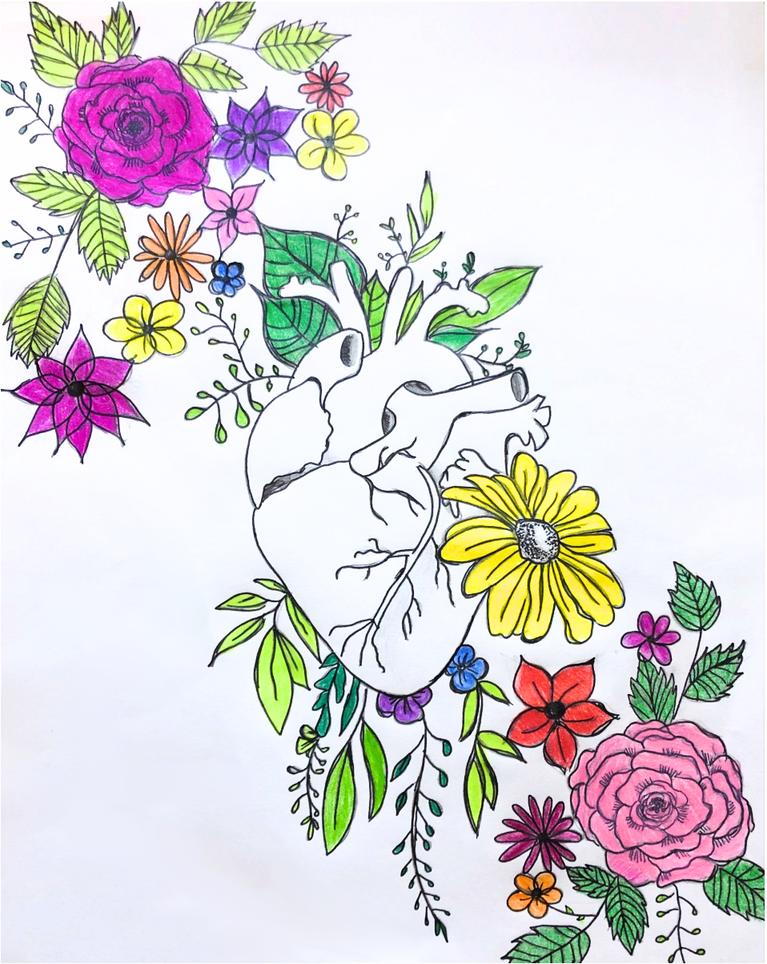

spring 2024 edition
the american muslim medical student association


Untitled Shanze Arshad 2 ToWearHijab Marwa Hassan 5 The Chapel Saadia Akhtar 6 Little Blue Prayer Rug Isra Wadood 7 Sternotomy Naimah Sarwar 8 Navigating Clinical Skills Training as a Muslim Medical Student Rawaan Khatib 10 Amanat Sana Chowdhry 12 I bear witness to heart failure Saniya Ahmed 14 Acknowledgements AMMSAEditors 16 c o n t e n t s Cover artwork: “Heart to Heart” by Sunia Khan
Untitled
Shanze Arshad
5 AM
Before even the sun realizes it is day
My day begins
Strange, isn’t it?
To be a stranger in a land That does not speak to your soul
No… pre-chart
These thoughts can wait
Pick apart each value AST, ALT, WBC, Hb
Just don’t pick yourself apart too
It’s time to round…Now
Not the circles you’ve been spinning in For the last few months (or decades?)
Don’t think about the bombs Or the children Or the mothers Or the fathers Or the families
This dance must continue Till the end?
They’re telling me I’m making a difference Paving the way for others like me
I walk into the OR With a hijab some nurse gave to me I get a little excited
2
It’s the first time this has happened
Is this the difference I made?
So trivial…
I look
The smiles and applause
…So long as I don’t say the G word
Surgery is over
I’m sewing a stranger
I’m trying not to buttonhole her skin
…Failing miserably
Then there’s the gauze
Out of place
From the Land of Olive Trees
Healing the wrong wounds
Time to study
Focus…Now
On all the intricacies of primary amenorrhea
Which I somehow don’t care for
There’s a protest
Should I go?
But I have to study
There’ll be another one later
Yet…
This one feels like the most important (Don’t they all?)
I end up going
We scream
We shout
They threaten to arrest us
We keep screaming
3
And eventually…
It’s 10 PM Then midnight
A new day begins… It has to
“BytheMorningLight Andthenightwhenitfallsstill YourLordhasnotabandonedyou”
4
ToWearHijabintheOR
Marwa Hassan
To wear hijab in the operating room (OR) as a medical student is an interesting experience. It is sending an email prior to your orientation to ask about scrub jacket availability. It is showing up early to be given a scrub jacket because further emails had to be sent to inquire about the location of them. It is being appreciative that the organizers of your rotation were willing to do this for you. It is being unsure whether you’ll find a scrub jacket each day. It is being told that there “should be” scrub jackets but that sometimes all that may be available is a 2 or 3XL. It is worrying that someone may comment on your hijab, although you’ve been told that you can wear it if you wear a bouffant cap on top of it. It is having this worry because you’ve heard stories of this occurring at other institutions. It is having someone remove your scrub jacket from around your waist- that was the way you could remain covered for the longest. It is being told that this is not proper sterility and being okay with being corrected. It is also having someone take this scrub jacket from your waist into the hallway without your knowledge during a case and standing and feeling bare after un-scrubbing with the door blocked as you await being able to leave. It is being told that there wasn’t space in the OR to place the jacket. It is feeling like you are the first hijabi to ever do this, but knowing for a fact that you are not. It is asking if there is a way to add a scrub jacket to hijab-wearing student’s scrub credits and being told it will be looked into, and hoping deep down that it truly will.
While writing this was somewhat therapeutic, I do not want any confusion surrounding my intentions. This was not a complaint, nor to seek pity. I have had many positive experiences, Alhamdulillah. I am not ashamed of my hijab, nor my experience with it. I only came to share a part of my journey. I do not know if my experience is a shared one, as my own experience changed from hospital to hospital and surgical rotation to surgical rotation all in the same city.
Lastly, to wear hijab in the OR is to have your best friend in your class tell you that she was approached on the same rotation later in the year and asked if she’ll need a scrub jacket since she wears hijab. It is smiling ear to ear and knowing that every challenge you faced was and will be worth it, inshAllah. It is paving the way for hijabis to come. It is pride. It is joy. It is beautiful.
5
TheChapel
Saadia Akhtar
The room is dark
But I can still see figures in sujud
Fitting in salah
Between laryngoscopies
And lunch
As I enter
Someone else exits
We give each other a Salaam
Nodding with the understanding
That our Lord comes first
Are they a patient?
A physician?
Or something in between
As I give my tasleem
I see another person enter
And give another Salaam
She introduces herself
A residency applicant applying for neurosurgery MashAllah
Names and numbers are exchanged
And I have someone new to do duafor
Every time I come
I look forward to meeting someone new
Hidden amongst the pews
Strategically placing their sujadah
To pray towards the ka’bah
Sometimes it’s a mother
Praying for her sick child
Or a student
In need of a miracle
Often, it’s a doctor
Trading their pager for prayer
Because in the chapel
Our badge comes off
The ladder of hierarchy is put aside
And when someone asks
“Who are you?”
There is only one thing we say:
We are Muslim
6
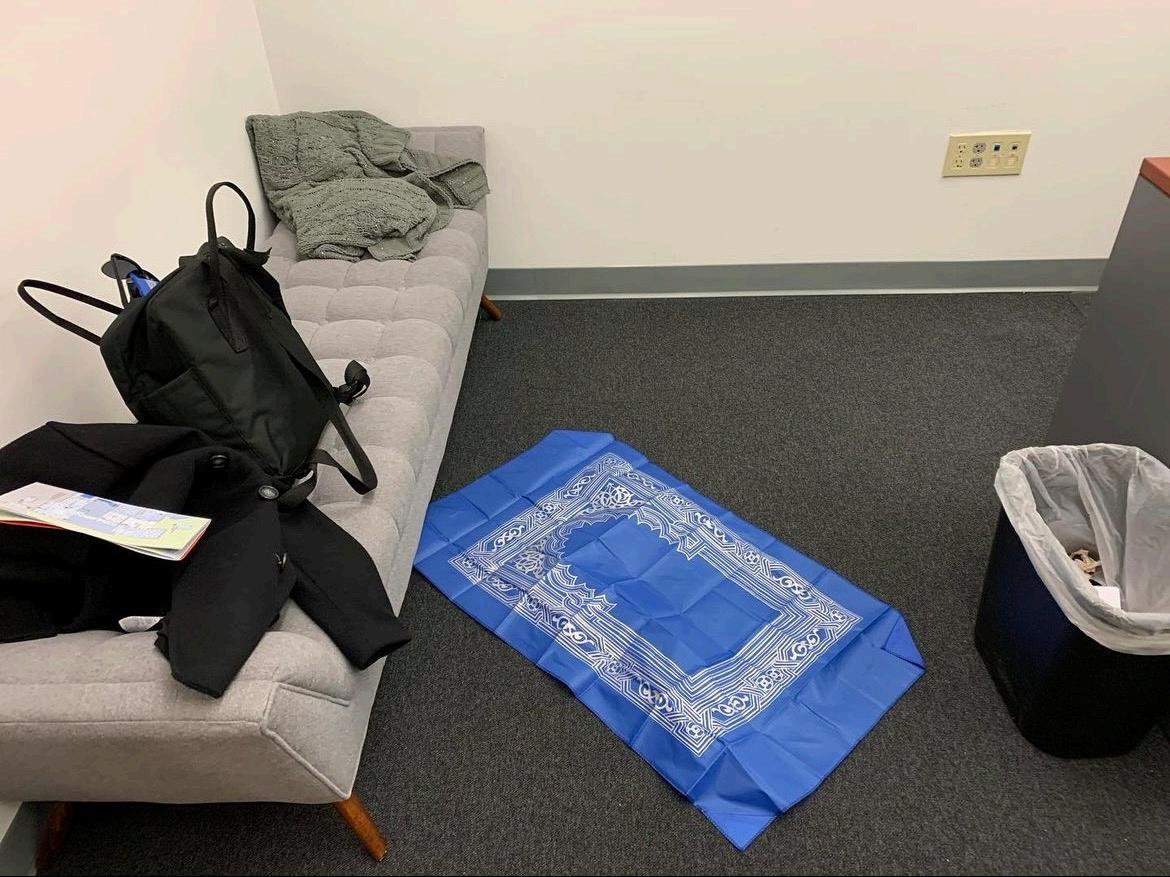


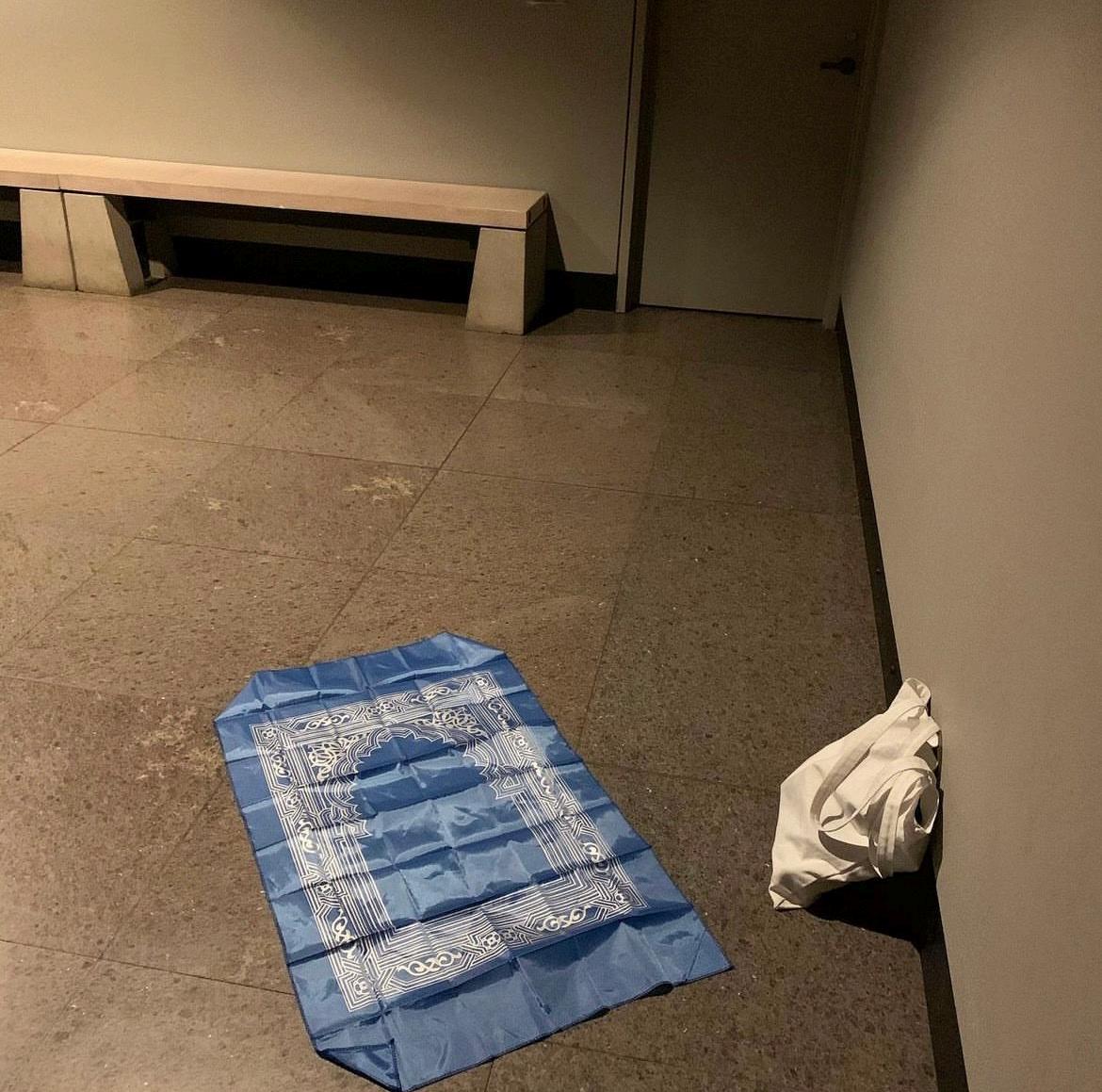




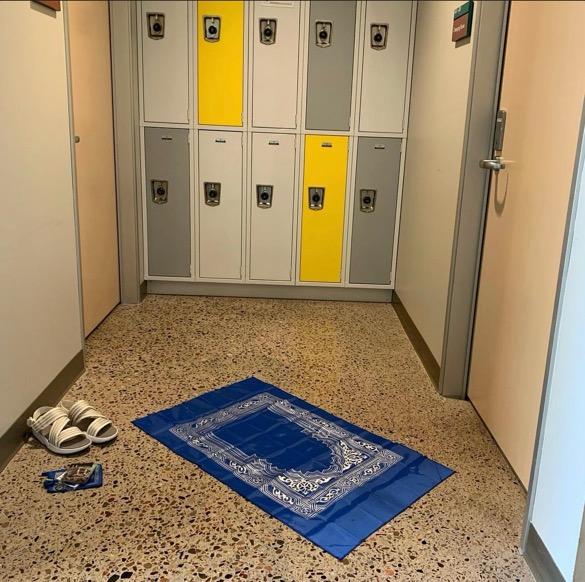
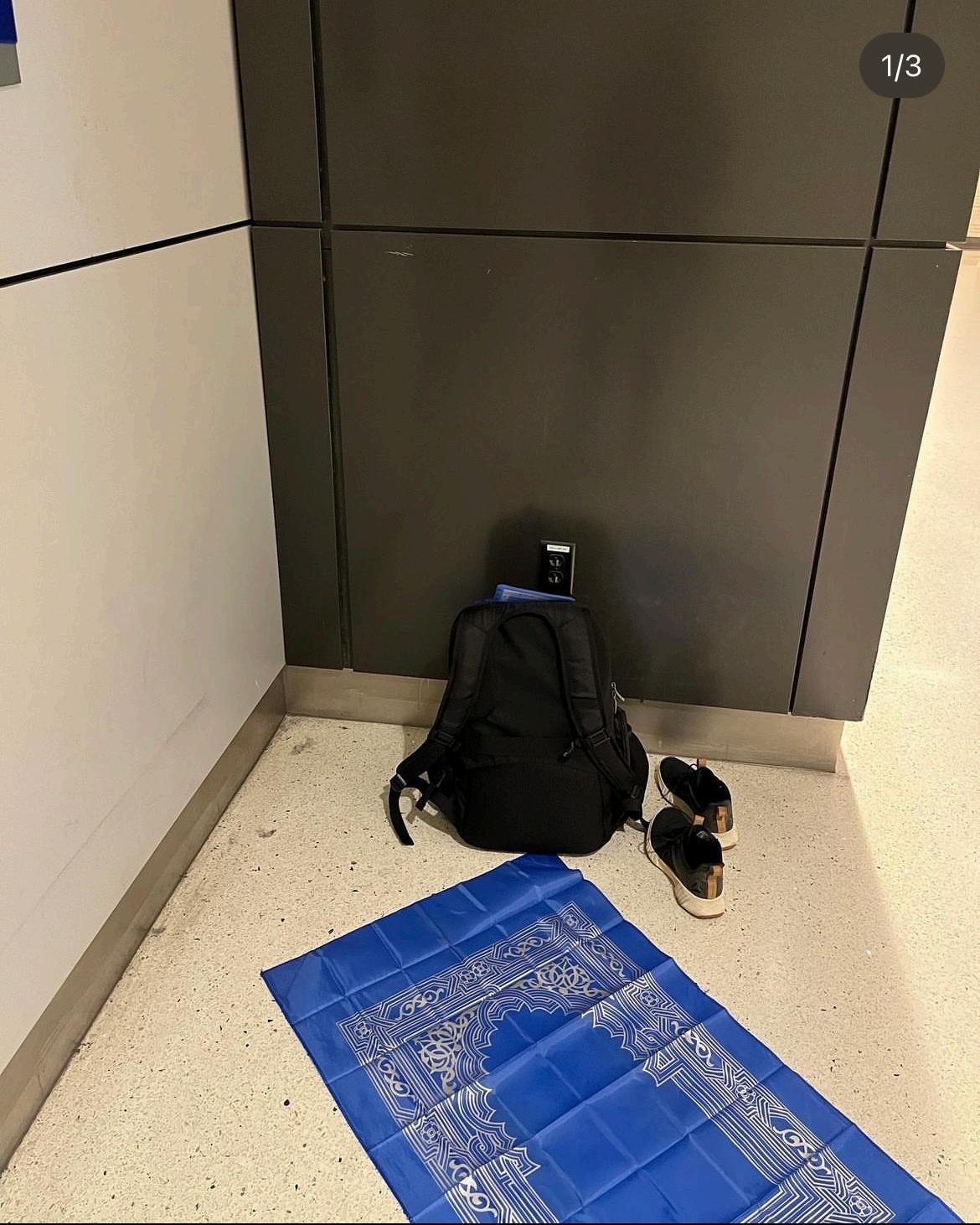
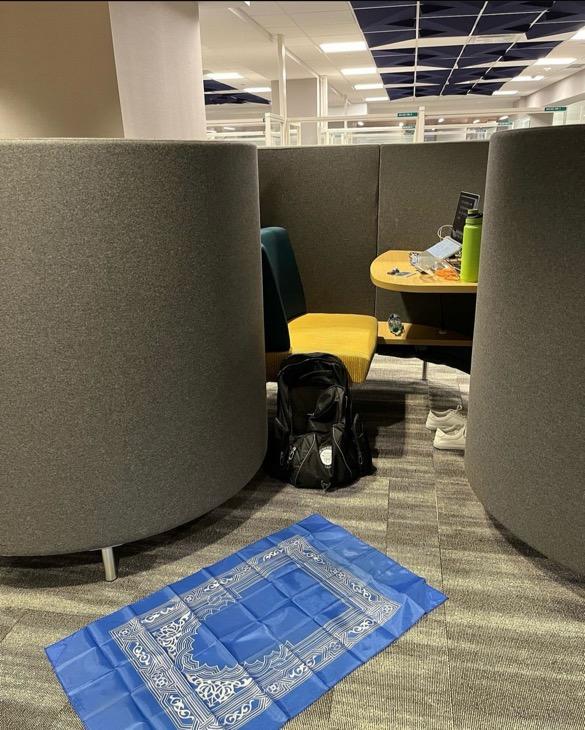
7
LittleBluePrayerRug
Isra Wadood
Sternotomy
Naimah Sarwar
I watch her raise the saw and place it perpendicular to his chest. Then the crack of the drill, then The Opening. I peer over the table on tiptoe hands clasped over my chest and I lift that still, slippery heart bathed in ice how light and how heavy and with her eyelash of a needle she begins to sew. And I stand holding his heart, holding my breath for an eternity between beats wondering how I ended up here in this bright room, over his open chest suspended between life and death. As I lie in bed that night, I remember cracking open pistachio shells with my grandfather as a child and wonder what remains in my chest.
If you cracked open my chest you might find a pilot light my ribs curved around it, like hands cupped around a flame shielding it as I scurry down hallways as I whisper prayers into paper towels on hospital floors. As I watch her ribs crack beneath hands clasped over her chest. As I turn to the nurse when it stops, Isthatit?And as my head hits the pillow that night, Isthatit
8
But sometimes, as I ask him how that heart I held for him has been beating and nod salaamon my way out of his room I find in my chest a light, perhaps as if lit by the oil of an olive tree and I remember, I have always been here between life and death this eternity between beats.
9
NavigatingClinicalSkillsTrainingasaMuslimMedicalStudent
Rawaan Khatib
Clinical skills is one of my least favorite activities in medical school. As a first year medical student, it often feels like I’m playing the role of a pretend doctor, all while being evaluated by real physicians. While I have no trouble engaging in conversation and maintaining a sense of normalcy outside of the exam room, the dynamic shifts drastically once I step inside. Inside the exam room, I find myself stumbling over my words, my attempts at practicing empathy sound rehearsed, and an overwhelming sense of awkwardness consumes me.
Following the interview portion, we transition to practice physical examination of the heart, lung, and abdomen. Personally, this is the hardest and most awkward part of the patient encounter because I wear the hijab. Quite literally, the hijab is a physical barrier between my ears and the stethoscope. On my first day practicing physical exam skills, I decided to style my hijab tightly wrapped around my head so it wouldn’t move throughout the day. Panic set in when I realized I would need to figure out a way to position my stethoscope without revealing my hair in front of my peers. In a room filled with 6-7 male and female medical students, a facilitator, and a standardized patient, I thought, “How am I supposed to put my stethoscope on without showing my hair?”. After being called up to practice with the facilitator, I vividly recall standing in front of my peers, grappling with my hijab as I attempted to adjust it to accommodate my stethoscope. The fabric repeatedly caught the instrument, and I struggled to find enough space for it to reach my ears. I struggled with multiple attempts, and what probably took 1-2 minutes felt like an eternity. Eventually, I was able to fit my stethoscope into my ears and practice for the physical exam.
After struggling with the practical challenges of wearing a hijab during clinical skills training, I searched for a solution that would allow me to comfortably and confidently perform physical exams. I was surprised to find multiple companies with different hijabs that provided discreet ear access. The models were shown using these ear holes to wear face masks, the stethoscope, and protective eye wear during surgery. Furthermore, I also found online tutorials on ways to style my hijab so I can wear the stethoscope comfortably. This made me appreciative of the Muslim healthcare professionals that endured similar struggles with hijab accommodations. Their innovative solutions have made practicing healthcare accessible to Muslim women worldwide. Through their efforts, I was able to find a hijab that allowed me to preserve my modesty while facilitating a full physical exam.
This short, but impactful experience made me realize being a Muslim woman in healthcare is not a novel concept. Muslim men and women have been integral in providing care in America for generations. It's crucial to recognize this legacy and avoid feelings of isolation on
10
our journey into medicine. Motivated by this realization, I am committed to striving for excellence in my medical career, serving as a representative of Islam in healthcare, and practicing my faith through my work. Furthermore, this experience has inspired me to pay it forward, working to ease the path for future Muslim medical students embarking on their journey to becoming physicians.
11
Amanat Sana Chowdhry
“Please. Tell me what to do, Doctor.”
“I’m sorry, I’m just a medical student, but my attending will be coming in shortly and we’ll figure out a solution together.”
My preceptor enters the room and the patient and I let out a sigh of relief. I walk towards my corner of the examination room, comfortable and familiar, as he begins addressing the patient’s concerns. My mind wanders. “I’mjustamedicalstudent” howmuchlongercanIhidebehind thosewords?
I think back to the moment when I received my acceptance into medical school. The elation, tethered quickly by a sinking weight which took months to identify. The realization of the amanat that I had been entrusted with. The weight of the responsibility I would eventually bear, both from the patients under my care and from The One who blessed me with this role. How willIbearthisonmyown?
At the start of my medical career, I silently studied my preceptors in their respective settings, searching for any strategies or methods they might’ve used to carry this immense weight. I follow one preceptor as he rushes out of one patient’s room and into another until he’s seen 20 patients, finally collapsing in his office, only to face a mountain of messages about insurance coverage, medication costs, financial insecurities. How his head hung lower with each message, how tightly his hands were bound.
“However much you do, Sana, it always falls short.”
One afternoon, my preceptor stopped briefly in the hallway to chat with another attending. I listened as they discussed hospital policy and politics, and the neverending, unanticipated obstacles they faced while trying to deliver their desired quality of patient care. The attending’s eyes flitted to meet my concerned gaze, then down to my student badge, and finally back to me with a sad smile.
“The burden of being a physician never gets any lighter.”
I stared back at him, as I experienced for the first time how this burden can be simultaneously isolating and unifying. For those who live outside the world of medicine, doctors are powerful, intelligent, “big” people. Truthfully, I’ve never felt smaller.
12
Now, as I near the end of my third year in medical school, I continue to reflect on how much I’ve already been shaped by the weight of this burden, although justamedicalstudent . My gratitude and fear grow hand in hand. HowblessedamItobechosenforajobwhereIaminaconstant stateofworship,caringfortheill?WhatwillIsaywhenIstandinfrontofAllah,andHeasksme whatIdidwiththepositionthatHeentrustedmewith?I carry this weight in my hands, like a one thousand-pound stone made of glass, humbled by both the power Allah has given me and my total lack thereof. When I feel myself start to crumble, I lean on the support of my peers, the strength of my mentors, the peace from my mother’s whispered duaas , and above all, Him. I remind myself that the dunyais not designed for comfort, and allow myself to fully experience the weight of this amanat. A weight that once crushed me, now a reassuring reminder of each step I take toward Him and my akhirah .
13
Ibearwitnesstoheartfailure
Saniya Ahmed
She sits at her desk day eclipsing into night as I am kept trapped and quiet between ribs the boy whispers the shahada to his baby brother coaxing the words to his tongue so he is comfortably welcomed Home the newly orphaned babies cry ringing grief into the air like missiles piercing clouds doctors discover their own families deceased as bodies are brought to emergency floors parents carry martyrs within the palm of their hands I cry out wounded from the shrapnel pulling my limbs out from under the rubble carrying parts of my youth in plastic bags she tries to bury me in the spine of her books crushed between pathogens and complement cascades as if the infectious injustice could be fixed by simple clotting as if pharmacological agents need memorizing when phosphorous bombs eradicate entire classes of schoolkids she turns off her socials as internet cuts out in Gaza to isolate without escape she wants to focus on building illness scripts as buildings fall aflame on her sisters and brothers I claw at her lungs filling the cavity with the blood of our people she winces at every breath reminded that humanitarian hospital rounds don’t have ceasefire so neither can her slow loss of humanity she drowns in survivor’s guilt suffocated by systems she operates in that remove her from herself and from her people it is easier to divide and conquer to sequester into confines of professionalism that push her into complacency she fails exams
14
and her people her mind and heart stretched across oceans her scarf soaking the wounds of the Ummah her soul sutured to the hands of humanitarian healthcare revolution is turmoil of keeping her head down to survive and study when all I want is to serve my people on the frontlines to stand against oppression everywhere to mourn the realities of my community and make endless dua’a for liberation and lives martyred someone said that successful completion of acts to become a doctor is a pledge of my service for my communities in the future but wombs become tombs and I worry what community will be left by the time I gain enough power what are we if not for our people what is worth our coin and skill if not for our people and our people are all people who face injustice sometimes we carry fear in our bones instead of faith instead of vessels of human experience our hearts sink into misconceptions and defensives but that does not change the burden of justice we joined medicine to heal not to be held from truth I titrate her soul into reality staining her white coat with fatigue and pain and remembrance and shackle her stethoscope to myself so while the world may suffer heart failure we will remain alive
Definitionsfornon-Muslimaudiences:
Shahada– the declaration of faith in the Islamic tradition, “I bear witness that there is no god but Allah, and I bear witness that Muhammad is His Messenger.” This is one of the five pillars of Islam. We recite this statement often but hope that it rolls off our tongues in our time of death so we may die with this declaration of faith.
Ummah– the global Muslim community, bound together by religion. Prophet Muhammad, peace and blessings be upon him, described the Ummah in this way: “The parable of the believers in their affection, mercy, and compassion for each other is that of a body. When any limb aches, the whole body reacts with sleeplessness and fever.” (Source: Sahih Al Bukhari 6011, Sahih Muslim 2586)
15
a c k n o w l e d g e m e n t s

From the American Muslim Medical Student Association (AMMSA), we sincerely thank our medical student members for their thoughtful submissions to the inaugural AMMSA Creative Works Initiative publication. We believe the strength of the Muslim community comes from the dialogue among many voices, and we are honored you chose to share yours with a community of peers. We intend for this publication to serve as an outlet for creative expression and reflection upon our professional and religious community. The works selected for this edition highlighted the strength we find in standing together, whether in hospital prayer rooms or in solidarity against silence.
From the intricate miracles of human anatomy to the personal fulfillment of connecting with patients, the practice of medicine serves as a daily renewal of faith. These moments motivate us to serve as sources of hope, strength, and faithful leadership, particularly when our responsibility to our deenoverlaps with our responsibility to our patients. May our words serve to uplift each other, and may our experiences encourage each of us to reflect more deeply on the duty and privilege to serve and learn from one another.
The AMMSA Creative Works Team
Sarah Siddiqui
Aisha Abdool
Saira Alvi
Naadir Jamaal
Sidra Siddiqui
16
كاﺰﺟ 'ٱ اﺮﯿﺧ
















